By Rollo Collins, Francesca Gentile and Kyle Glen
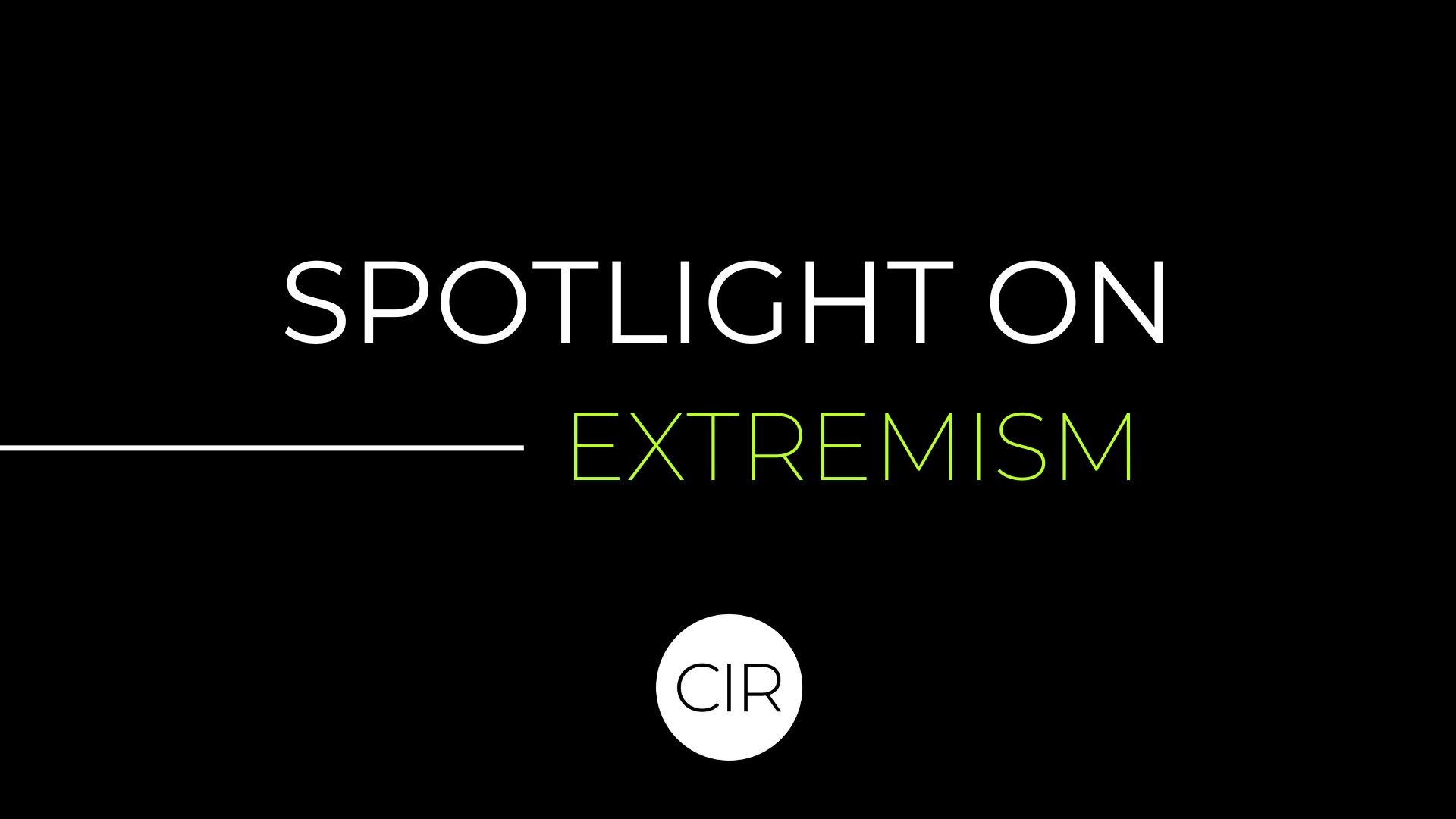
The first article of our new series “Spotlight on Extremism” looks into the conspiracy theories that were circulating on social media in the aftermath of the wildfires in Maui, Hawaii in 2023.
CIR has redacted most links due to privacy concerns and to avoid amplifying harmful content. Upon request, CIR can share any relevant data as appropriate.
During the second week of August, a series of wildfires spread on the Hawaiian island of Maui. The fires, fueled by Hurricane Dora’s heavy winds, destroyed the town of Lahaina, burning down residential buildings, restaurants and historical landmarks. Within hours of the fires, accounts on X (formerly Twitter) started sharing posts with pictures of the wildfires alongside conspiratorial narratives and captions containing misleading information. The most prominent narrative, which has been adapted to different natural disaster situations, is the belief that the wildfires were caused by the use of Direct Energy Weapons (DEWs).1
Studies have shown that since Elon Musk became X (formerly Twitter)’s CEO a surge in hate speech and conspiracy theories has occurred on the platform. Conspiracy theories are frequently amplified by extremist groups, including far-right extremists, who use them to further exacerbate tensions in society by reinforcing the identity of the “in-group”; to justify and potentially promote violence; and to radicalise and recruit individuals to their groups.2 With Musk advocating for freedom of speech on X (formerly Twitter), the platform has become a safe space for far-right extremists to amplify conspiracy theories and mis/disinformation.3
CIR researchers noted that a majority of the posts containing mis/disinformation on the Hawaiian wildfires shared on Twitter (formerly X), were then also amplified on other social media platforms, such as TikTok and Instagram. This article will shed light on the conspiracy theories spread during the Hawaiian wildfires; the reasons why conspiratorial narratives tend to flourish during natural disasters; and the inability of social media platforms to curb the amplification of conspiracy theories online.
Hawaiian wildfires and conspiracy theories: what were accounts spreading online?
CIR researchers identified six common conspiracy theories that were amplified on X (formerly Twitter), TikTok and Instagram following the wildfires: the presence and use of DEWs; the “blue theory” conspiracy; narratives blaming the government of the United States (US); conspiracies against China’s interference in the wildfires; and narratives blaming Hollywood actors and the ‘elites’ for starting the fires.
CIR assessed that the most prominent conspiracy theory that circulated on X (formerly Twitter) during the Hawaiian wildfires was that the fires were not natural but a consequence of the use of Direct Energy Weapons (DEWs – at times even referred to as “space lasers” by certain accounts). This narrative, used during the California wildfires in 2018 (explained in detail in the following section), was repurposed to explain the situation in Hawaii.
On X (formerly Twitter), various accounts shared posts with footage of burnt buildings, cars and houses in Lahaina, claiming that it was proof of the use of DEWs because of the power and precision with which some areas were completely destroyed while others were left untouched. Some users also believed that proof of the use of DEWs could be seen from completely melted cars, which users claimed to be an anomaly. Below is an example of the type of posts that users on X (formerly Twitter) shared on the use of DEWs during the Hawaiian wildfires.
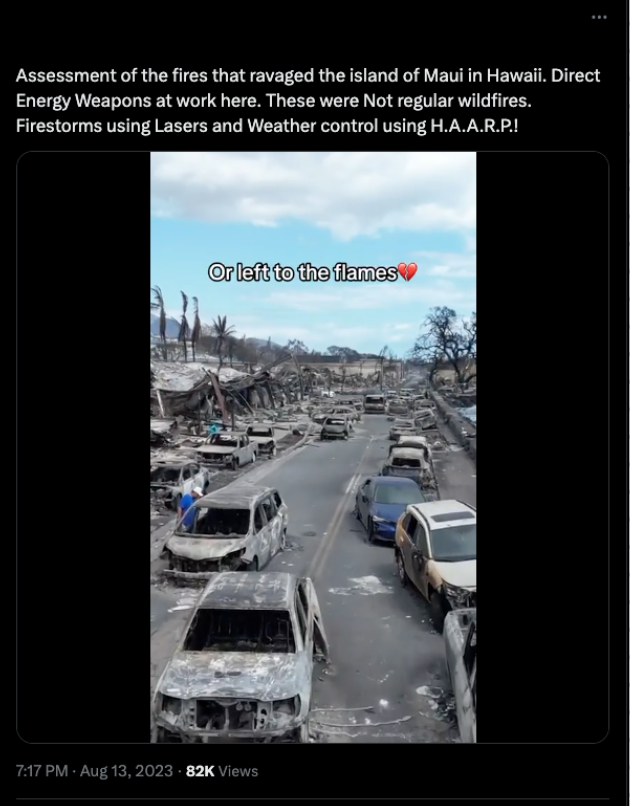
Figure 1: a screenshot of an X (formerly Twitter) account posting about the use of DEWs in Maui, Hawaii.
As evidence to support their claims of lasers being used, accounts on X (formerly Twitter) and TikTok also shared videos and posts of blue items remaining intact from the wildfires. The “blue theory” conspiracy was shared by some users with the idea that lasers are programmed to avoid burning blue objects.
Some TikTok users tried to make connections between the United State’s Federal Emergency Management Agency (FEMA) and blue objects in Hawaii as a result of the FEMA policy of repairing damaged roofs with a blue tarp: the US government’s blue roof program has been around since at least 2004 with the project being widely used in the aftermath of Hurricane Katrina and several hurricanes in Florida, there are also mentions of ‘blue tarp’ roofs being used in hurricane repairs in 2002. Below are two examples of posts shared by accounts on X (formerly Twitter) claiming that blue objects were not destroyed during the wildfires.
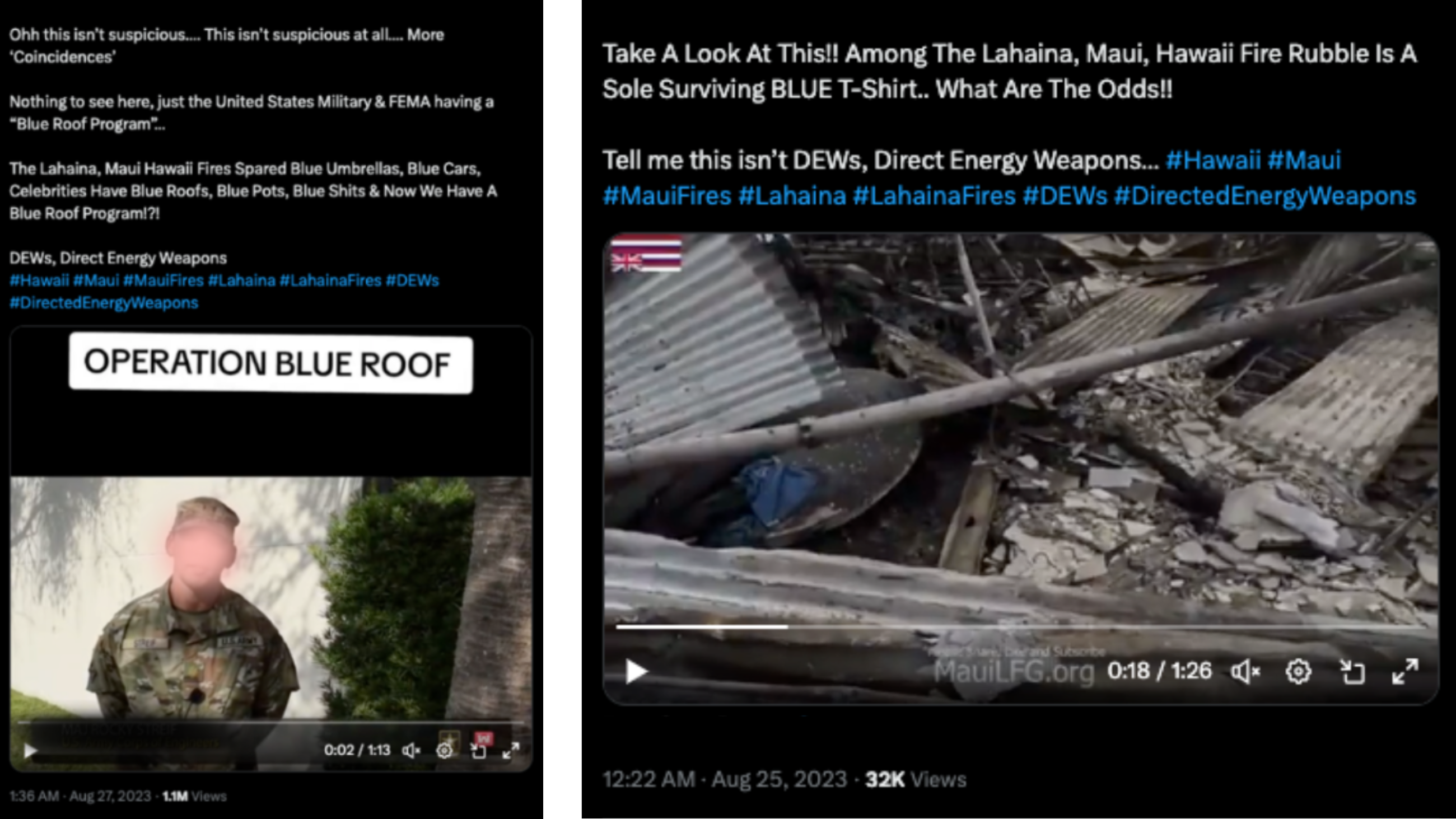
Figures 2 & 3: (left) screenshot of an X (formerly Twitter) account posting about the blue theory conspiracy and sharing a video of FEMA’s “blue roof operation”; (right) screenshot of another X (formerly Twitter) account sharing a video with the blue theory conspiracy, claiming that DEWs were used as blue items were left untouched by the fires.
CIR researchers were able to debunk the “blue theory” conspiracy by analysing open-source satellite imagery hosted by Google Earth, finding several examples of properties in the town of Lahaina with blue roofs that were completely destroyed by the fires (Figure 4 & 5).
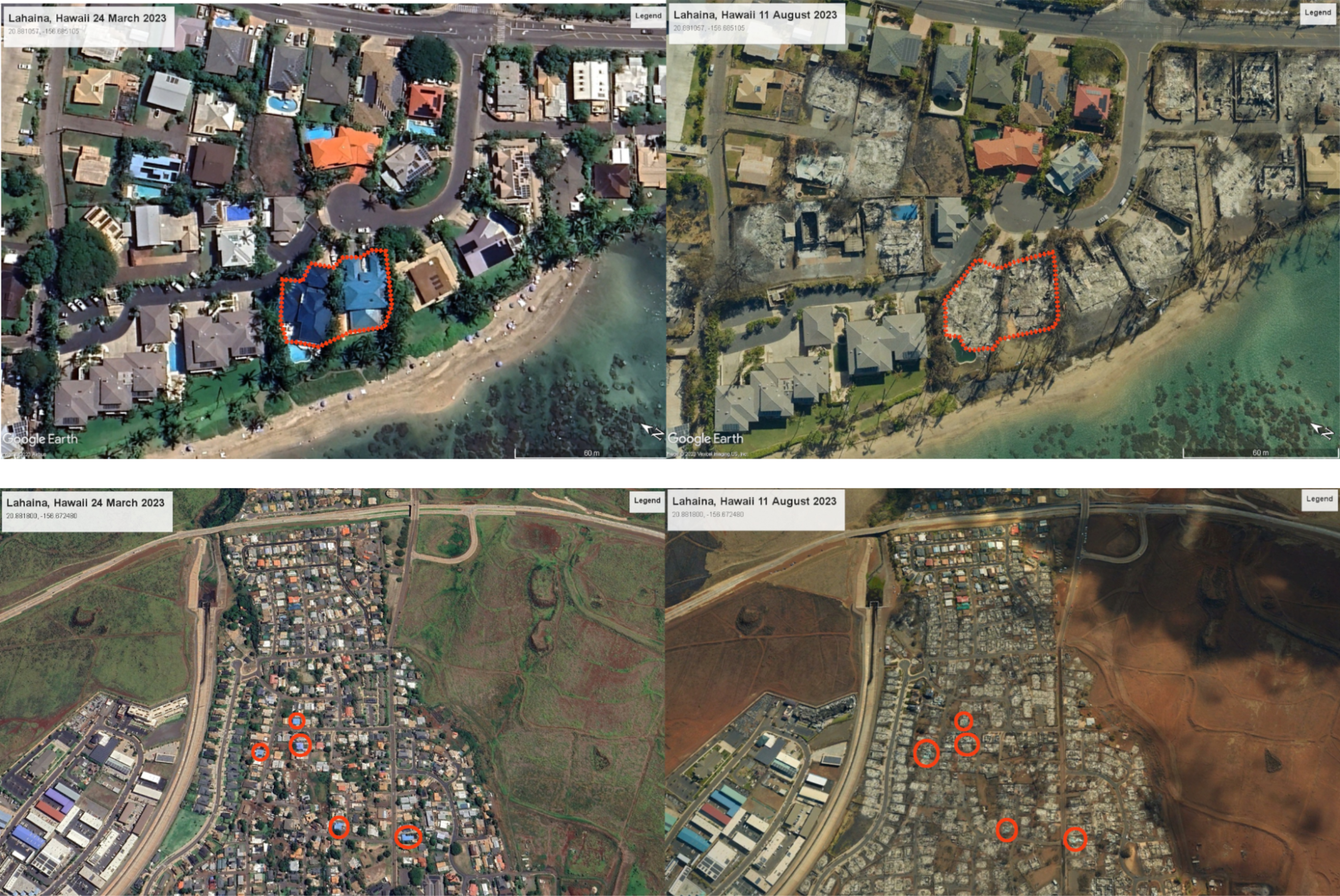
Figures 4 & 5: images from Google Earth, showing houses before and after the wildfires. Highlighted in red are the blue-roofed houses that were burnt down after the wildfires.
CIR researchers found accounts on X (formerly Twitter) spreading other anti-government conspiracies. Some users shared posts claiming that the US had used DEWs against its own citizens to advance its political agenda; others believed that the fires were a pre-planned attack organised by the US government. Below is an example of an X (formerly Twitter) account sharing a post claiming that the US government and China were to blame for the wildfires.
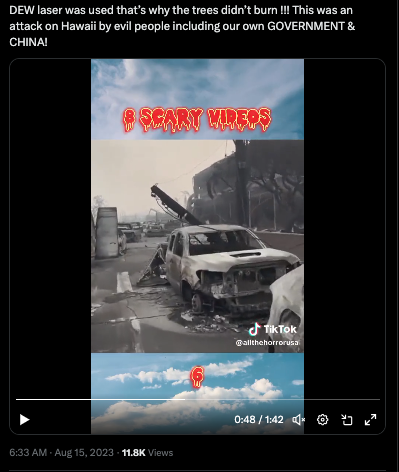
Figure 6: a screenshot of an X (formerly Twitter) account claiming that the US government and China were to blame for the wildfires in Hawaii.
As seen in Figure 6, some X (formerly Twitter) users blamed the People’s Republic of China (PRC) for starting the fires by using “their more advanced space lasers”. Amongst these users was David Icke, a prominent British conspiracist, who shared a video article entitled “CCP Satellites Over Maui At Times of Fires” on his website. This in turn prompted state-affiliated news channels in China, such as Global Times, and pro-PRC influencers to call out the US for spreading misleading information on China’s involvement in the wildfires.
Lastly, on TikTok and Instagram, celebrities and the ‘elites’ owning land in Maui became the focus of conspiracy theories. For example, Oprah was blamed for starting the fires so that she could “acquire more land” in Maui. Celebrities and ‘the elites’ whose houses were left untouched by the fires were also blamed: users claimed that the elites started the fires as part of their plot to “get rid of low-income people”. Some users on X (formerly Twitter) shared posts claiming that the fires were started to “depopulate the island” and guarantee cheaper land and property costs for buyers.
Understanding the relationship between far-right extremists, conspiracy theories and natural disasters
Conspiracy theories often flourish when drastic world events, such as natural disasters, occur – creating an uncertain and fearful environment. Individuals who believe in conspiracy theories do so because they offer alternative and simplistic answers to unpredictable and inexplicable world events, which would otherwise be difficult to understand.4 Conspiracy theories also place blame on a specific actor (usually seen as an enemy), ultimately facilitating one’s understanding of the event. Far-right extremists use conspiracy theories to reinforce a sense of in-group identity, by placing blame on a specific “out-group” (usually seen as the enemy)5; to justify and promote the use of violence, usually against the perceived out-group; and to radicalise and recruit individuals.6
Specifically, the far-right’s willingness to adopt conspiracy theories surrounding natural disasters can be understood within the context of an overarching climate denialist position. Although the far-right more broadly has seen a shift away from climate denialism, particularly in Europe, it remains a core tenet of far-right ideology in the US.7
Presented as part of a wider ‘globalist agenda’, many mainstream and fringe individuals, like Nick Fuentes (a white suprematist livestreamer and political commentator), identify climate change as a hoax, often to the benefit of ‘globalist elites’ or as a means of degrading the standard of living for the American public. Within this context, the adoption of natural disaster conspiracy theories acts as an opportunity for elements of the far-right to attribute blame towards a pre-existing and malignant out-group and, as a result, disprove the notion of climate change. In its basic terms, these far-right individuals claim that the out-group manufactures these disasters to further encourage the ‘climate agenda’ which subsequently benefits global elites and degrades a pre-established, and conservative, way of life.
The wildfires in Maui were not the only instance in which conspiracy theories related to natural disasters were spread. For example, in 2018, anti-Semitic conspiracy theories flourished during the California wildfires. Congresswoman Marjorie Taylor Greene shared posts on her social media claiming that the California wildfires were not natural but caused by a “Jewish space laser” owned by the Rothschild family.8 In 2021, climate denialism fueled conspiracies on Hurricane Ida, which made a landfall in the US state of Louisiana. Supporters of QAnon9 believed that the hurricane was “man-made” and that the “deep-state”10 manipulates and controls the weather.
In 2023, a couple more natural disaster situations promoted conspiracy theories. Claims on the use of DEWs were repurposed during the wildfires in Greece in August 2023 and during the earthquake that hit Morocco in September 2023. Although posts on the Greek wildfires did not receive as much traction as those referencing Hawaii, they were still viewed by more than 5,000 people (Figure 7).11 For the earthquake in Morocco, users on X (formerly Twitter) shared posts claiming that laser-like lightning hit Morocco before the earthquake happened (Figure 8).
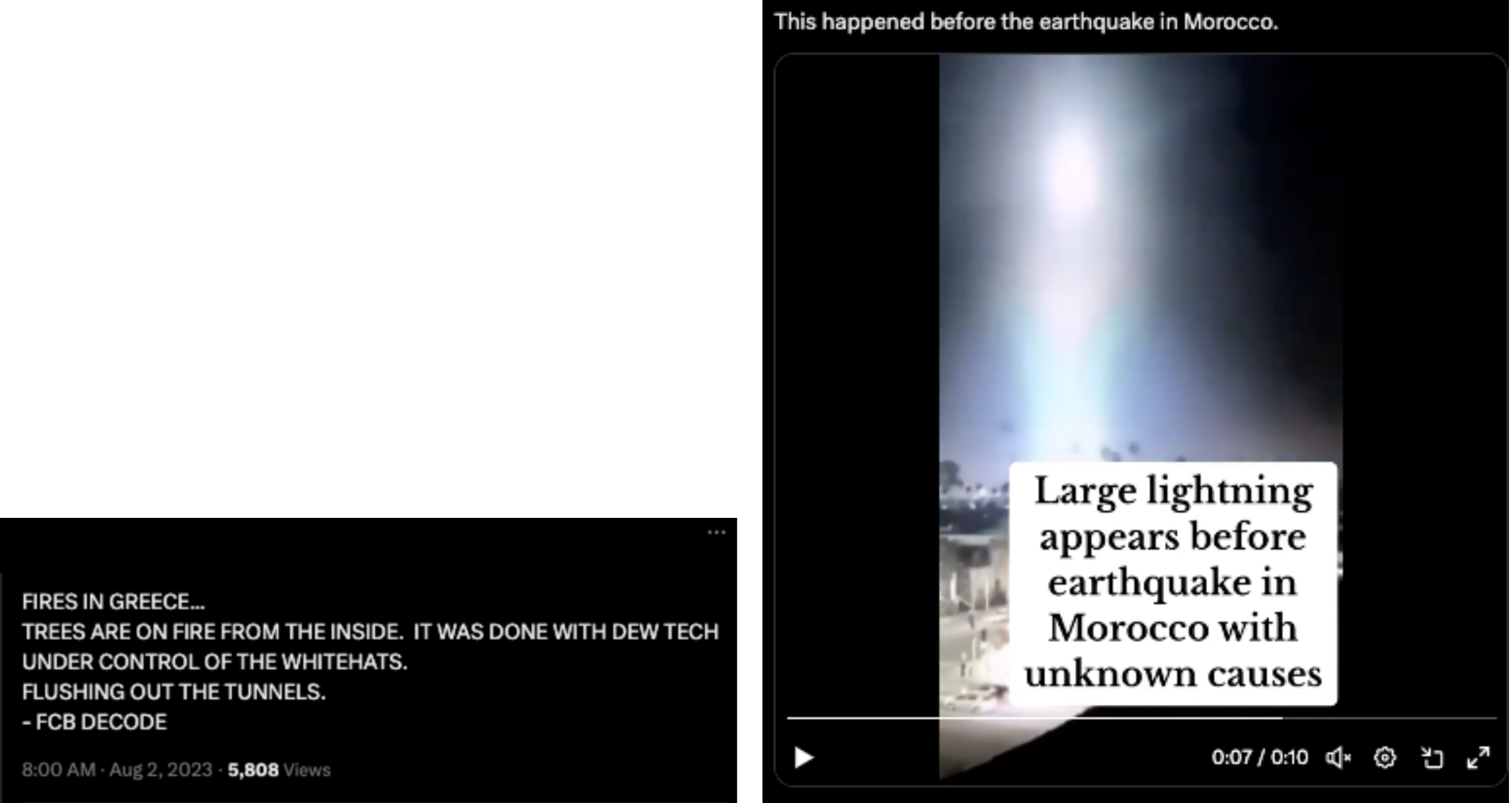
Figures 7 & 8: (left) screenshot of an X (formerly Twitter) user claiming that the fires in Greece were caused by the use of DEWs; (right) screenshot of an X (formerly Twitter) account claiming that laser-like lightning hit Morocco before the earthquake happened.
Social media accountability: what are social media platforms doing?
Social media platforms’ inability, or supposed unwillingness, to fact-check information and curb the spread of conspiracy theories has resulted in a proliferation of mis/disinformation online. With Musk taking over X (formerly Twitter) and turning it into a space where people can talk freely, users have seemingly become more inclined to spread hate speech, conspiracy theories and mis/disinformation.12 Content moderation procedures are lacking on X (formerly Twitter), ultimately causing misleading and harmful content to be amplified.
Although X (formerly Twitter) has ostensibly taken proactive steps to address misinformation and hate speech on its platform through the establishment of ‘Community Notes’ in December 2022, the visibility and subsequent efficacy of these notes are dependent on users, not X (formerly Twitter) staff.
Designed to provide additional context or debunk misleading claims, Community Notes (previously Birdwatch), allows for contributors to fact-check posts with an added note below the post which, if approved by enough contributors, becomes visible to the wider X (formerly Twitter) user-base. This ‘ideological consensus’, according to MediaWise Director Alex Mahadevan, is almost impossible to achieve due to an increasingly polarised digital environment.13 Yoel Roth, formerly Head of Trust and Safety at Twitter, agrees, adding that the previous iteration of Twitter’s trust and safety policy saw a combination of community-driven and centralised Twitter-based fact-checking, a policy that has now been removed at X (formerly Twitter).14
Despite these issues, some posts containing misleading information regarding the Hawaiian wildfires were debunked by the Community Notes feature.
In the example below, an X (formerly Twitter) user, @MattWallace888 (1.3M followers), shared a video of a laser-like explosion occurring in what he claimed was Hawaii. The community notes, below the original post, provided factual context explaining that the video was not taken in Hawaii but was in reality an explosion that occurred in Chile in May 2023.
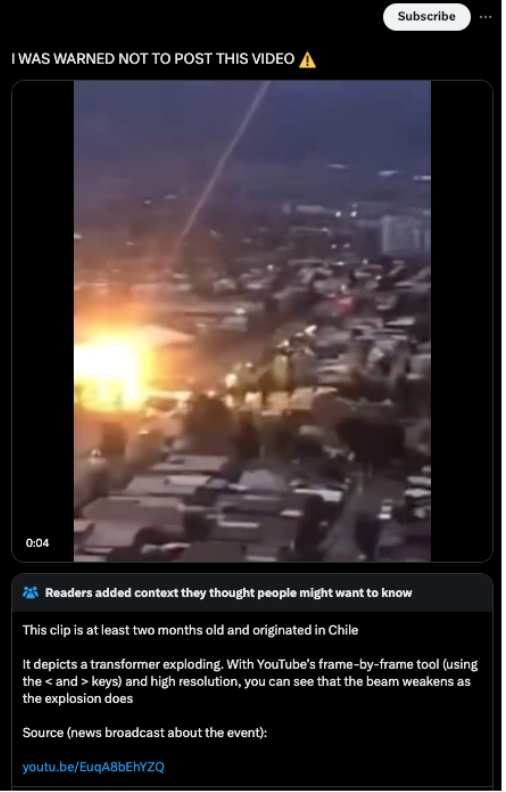
Figure 9: a screenshot of an X (formerly Twitter) account sharing a video of a laser-like explosion hitting a town. The video was debunked by X (formerly Twitter) users with factual evidence.
TikTok has, for a number of years, attempted to curb misinformation on its platform by restricting content it deems unsafe and dangerous, including content relating to medical misinformation and extremist positions (such as Holocaust denial). However, although TikTok has previously taken action against far-right and extremist conspiracies, including QAnon, its content algorithm results in users becoming more exposed to misinformation and extremist rhetoric.15 Throughout CIR’s research, no content warnings or restrictions were identified regarding conspiracies about the scale or cause of the Maui wildfires. A failure to provide sufficient fact-checked information, along with users’ determination and ability to ‘game’ the system, has resulted in the proliferation of misinformation, including information regarding natural disasters, on the platform.16
Conclusion
This article investigated the most common conspiracy theories spread during the Hawaiian wildfires by far-right extremists on a variety of social media platforms. Although the vast majority of conspiracies were shared by accounts on X (formerly Twitter), many conspiracies were also amplified on TikTok and Instagram.
CIR researchers assessed that the most prominent conspiracy theory that circulated online during the wildfires was that the fires were not natural, but were caused by DEWs. To support their claim of DEWs being used, accounts on social media platforms shared what they considered to be “evidence”, alongside also blaming the US government, China for being involved in the wildfires, and ‘the elites’ for starting the fires.
The article also seeked to provide an understanding of the relationship between conspiracy theories and natural disaster situations. The Hawaiian wildfires were not the only instance in which conspiracy theories were spread after a natural disaster, and unfortunately, will not be the last. Existing literature has demonstrated that extremist groups, including far-right extremists, exploit natural disaster situations and spread conspiracy theories to advance their agenda (from radicalising individuals, mobilising their base, and to further exacerbating tensions in society). What is of particular pertinence is how far-right extremists weave pre-existing narratives and tropes into their understanding of these natural disasters.
Given the fact that social media platforms are doing very little to curb the amplification of mis/disinformation and conspiracies and have, in cases like X (formerly Twitter), removed content moderation policies, accounts can more easily spread conspiracy theories online. A crucial step in preventing and limiting the amplification of conspiracy theories online, would be to understand, by carrying out further research, the relationship between far-right extremists, conspiracy theories and natural disasters.
Rollo Collins is an Open-Source researcher at the Centre for Information Resilience, specialising in civilian harm and human rights violations during the Russian invasion of Ukraine, online disinformation, and the modern far-right.
Francesca Gentile is an Open-Source researcher at the Centre for Information Resilience, specialising in disinformation narratives, social media monitoring, information operations and far-right extremism.
Kyle Glen is an Open-Source analyst at the Centre for Information Resilience, specialising in monitoring the Russian invasion of Ukraine, disinformation narratives, social media monitoring and far-right extremism.
“Spotlight on Extremism” is a series of articles based on investigations our CIR analysts conducted into some of the extremist ideologies that are circulating online. The articles will cover multiple narratives, events and concepts related to the broader sphere of extremism with the aim of analysing the impact it has on societies and furthering an understanding of the concept.
1 Direct Energy Weapons (DEWs) are a type of weapon that uses concentrated electromagnetic energy against its target(s), with lasers being an example of DEWs. Governments worldwide are researching and developing DEWs for military purposes, but they have yet to be used in real world scenarios. Climate denialists and conspiracy theorists have used DEWs to explain several natural disaster situations.
2 Existing literature on the use of conspiracy theories by extremist groups can be found in: Rottweiler and Gill (2020) Terrorism and Political Violence, Available at: https://www.tandfonline.com; van Prooijen and Douglas (2017) Memory Studies, Available at: https://journals.sagepub.com; Amarasingam (2019) Jihadist Terror, New Threats, New Responses, Available at: https://www.researchgate.net; Rousis, Richard and Wang (2020) Terrorism and Political Violence, Available at: https://www.tandfonline.com; Crawford and Keen (2020) CTC Sentinel, Available at: https://ctc.westpoint.edu
3 Warzel (23 May 2023) The Atlantic, Available at: https://www.theatlantic.com
4 See footnote 2
5 The out-group can vary depending on the narrative that is being spread. The out-group usually consists of either the government, a specific race, community or religion.
6 See footnote 2
7 Serhan (2021) The Atlantic, Available at: https://www.theatlantic.com & RUSI (11 May 2022), Available at: https://www.youtube.com
8 The Rothschilds, a wealthy Jewish family in the banking business, have been at the centre of anti-Semitic conspiracy theories. Far-right extremists believe the Rothschilds are part of “the elites who control world events”.
9 QAnon is a decentralised far-right political movement that emerged on 4chan in 2017 when an anonymous user named “Q” started sharing “secret” information about the US government. The movement is based on the belief that the world is controlled by a cabal of Satan-worshipping paedophiles. In 2021, QAnon supporters were involved in the Capitol Hill insurrection. Anti-Defamation League, (Last accessed 28 September 2023). Available at: https://www.adl.org
10 The “deep state” is a conspiracy that claims there is a secret network of government officials who have the power to influence and enact government policy. QAnon supporters believed that the “deep state” undermined Donald Trump’s presidency. Anti-Defamation League, (Last accessed 28 September 2023). Available at: https://extremismterms.adl.org
11 During the wildfires that hit Greece in 2019, posts on X (formerly Twitter) referred to the use of DEWs but did not receive the same engagement as the 2023 posts. In addition, similar claims were made in the aftermath of Greece’s 2019 fires as were made in the Hawaii wildfires, with some users claiming that trees remained standing while cars melted.
12 BBC Monitoring (March 2023) Available at: https://www.bbc.com [accessed 19 December 2023]; Warzel (23 May 2023) The Atlantic, Available at: https://www.theatlantic.com; Center for Countering Digital Hate (June 2023) Available at: https://counterhate.com [accessed 19 December 2023]; Frenkel and Conger (December 2022) The New York Times, Available at: https://www.nytimes.com
13 Czopek, M. (2023) Poynter Institute, Available at: https://www.poynter.org
14 Ibid.
15 BBC (September 2023) Available at: https://www.bbc.co.uk & BBC (July 2020) Available at: https://www.bbc.co.uk
16 Keith (2021) Business Insider, Available at: https://www.businessinsider.com

